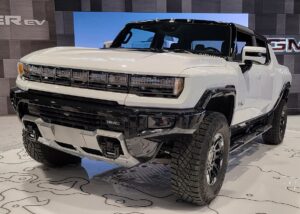CHARLOTTE, North Carolina – The Army is now accepting proposals for its Electric Light Reconnaissance Vehicle (eLRV) program, while a lead official noted funding to move forward on prototyping activities remains “tied up” with the delayed fiscal year 2024 budget.
A Request for Prototype Proposals (RPP) was released to members of the National Advanced Mobility Consortium on Feb. 15, with the Army planning a two-phased prototype effort for what will likely be the service’s first hybrid-electric tactical vehicle.

“Until we get resolution on what the budget is, we can’t award anything at this point. If we get a favorable budget, then the program will proceed,” Mark McCoy, who leads the Joint Program Office Joint Light Tactical Vehicles (JPO JLTV), told Defense Daily at last week’s NDIA Tactical Wheeled Vehicles Conference in Charlotte, North Carolina.
The Army can’t initiate new start programs, such as eLRV, while operating under a continuing resolution. Congress is likely to take up a final FY ‘24 defense spending bill in the coming weeks after months of the federal government operating under stopgap funding measures (Defense Daily, March 1).
Last February, the Army confirmed it had approved a prototype requirement for eLRV and said its FY ‘24 budget request would include funds for “working the early stages of the program” (Defense Daily, Feb. 28 2023).
“We got approval to do a Middle Tier Acquisition [authority] for rapid prototyping of the eLRV. It’s a two phase process. The first phase, we’re going to ask contractors to deliver some commercial-type prototypes, what’s readily available. Those will go into testing to help inform requirements. And then the next phase is to get more of a militarized prototype vehicle to do additional testing and assessments. Then there will be a downselect of what we would like to take into production,” McCoy told Defense Daily.
The eLRV is intended to provide Army scout squads an upgraded platform with a reduced acoustic and thermal signature while offering silent mobility and silent watch capabilities, increased dash speed, extended range, greater reliability and reduction in fuel requirements over the current Humvee platform, the service has noted previously.
“We’re not directing a pure electric solution for that. It could be a hybrid or an electric [solution],” McCoy said.
NAMC’s notice on the RPP adds that eLRV is the first capability being pursued under the Army’s new Tactical and Combat Vehicle electrification (TACV-e) initiative, and is intended to operate alongside the new General Dynamics Land Systems [GD]-built M10 Booker combat vehicle and GM Defense’s [GM] Infantry Squad Vehicle.
“The Army has a requirement for an electric Light Reconnaissance Vehicle that will provide the Infantry Brigade Combat Teams enhanced mobility, lethality, protection, mission load capacity and onboard power for a six-soldier Scout Squad with their associated equipment to conduct combinations of mounted and dismounted reconnaissance and security missions,” NAMC wrote in a notice along with the RPP.
A draft RPP for eLRV published in October stated that an eventual production contract for the program may be worth an estimated $672 million and cover production of nearly 1,500 vehicles (Defense Daily, Oct. 23 2023).
In July 2022, the Army awarded deals to GM Defense and advanced mobility startup Canoo [GOEV] to each provide an electric vehicle for demonstration, with the goal of informing the eLRV program (Defense Daily, July 26).
McCoy noted that effort concluded early last year after assessing the commercial platforms at Camp Grayling in Michigan, to include looking at how the Army would get after mobile tactical recharging in austere environments.
“We looked at how they performed in more of a military-type environment. That helped to shape and inform the requirements as we see them today,” McCoy said.
Tim Goddette, deputy assistant secretary of the Army for sustainment, told attendees at last week’s NDIA TWV conference the service is still looking at target goals to field its first hybrid-electric tactical vehicles in 2035 followed by fully-electric platforms in 2050 (Defense Daily, Feb. 27).
During a panel at the conference, McCoy was asked if JLTV will be the Army’s first purpose-built hybrid-electric tactical vehicle by 2035 and suggested that eLRV is likely to get there first.
“I would say, given we already initiated the eLRV program and that it’s likely to be a hybrid-type system, that’s probably going to be the first [hybrid-electric] ground-up system that’s going to be out there, probably before the JLTV. But they’re on similar timelines, as we do hybrid-electric JLTV as well. It could be a race to the finish, I guess, to see who actually gets there first,” McCoy said.
The JPO JLTV last week also published a market survey to help inform requirements for getting after integration of hybrid-electric technology on its JLTVs and Humvees.
“It’s trying to seek industry’s assessment of those requirements, what’s achievable, what’s not. [And it’s informing] do we need to make adjustments before we officially put that out on the street. [It’s helping] kind of get the right balance of what’s achievable from a maturity standpoint, what’s affordable and then also taking into [consideration] our individual constraints with each vehicle that it has to be integrated with,” McCoy told Defense Daily. “Right now, we’d like to do hybrid-electric [capability] for JLTV and Humvee. And we’d like to ensure commonality of components and approaches to the architectures that would be done for each one so we don’t end up with disparate individual components that drive different sustainment [requirements] and make it difficult to support the systems into the field.”